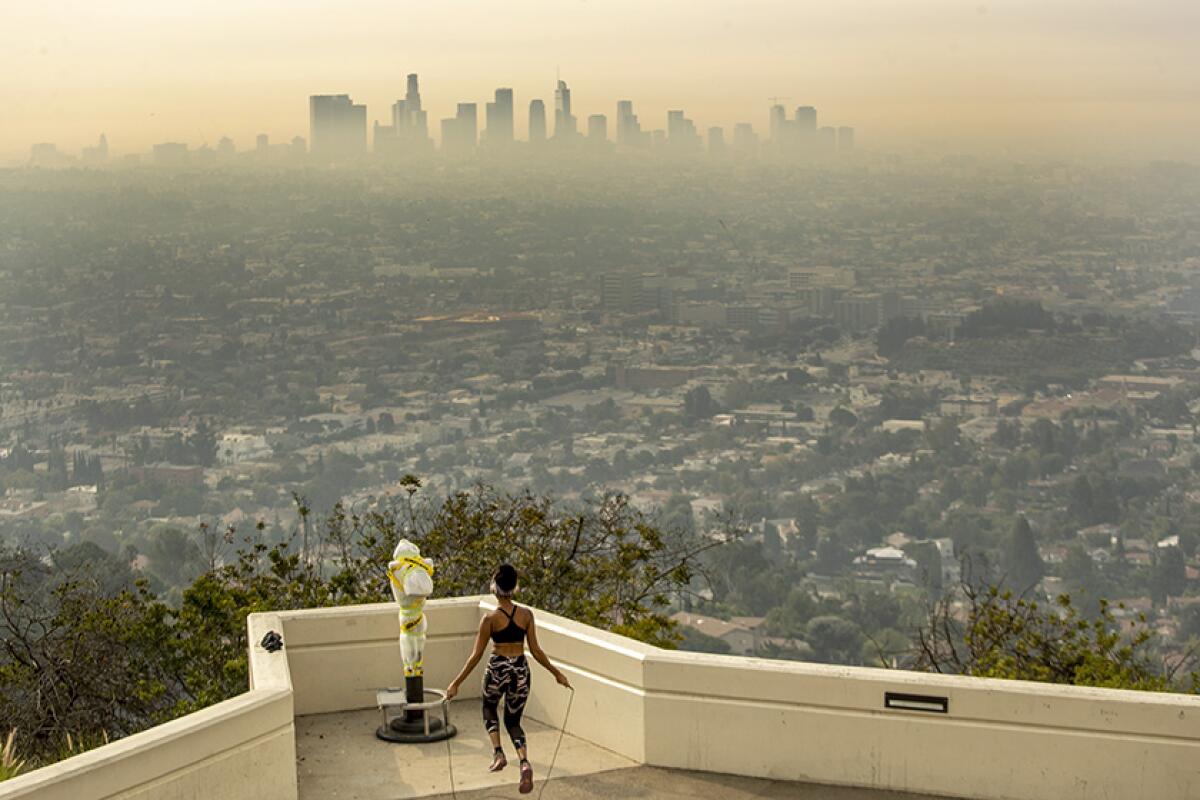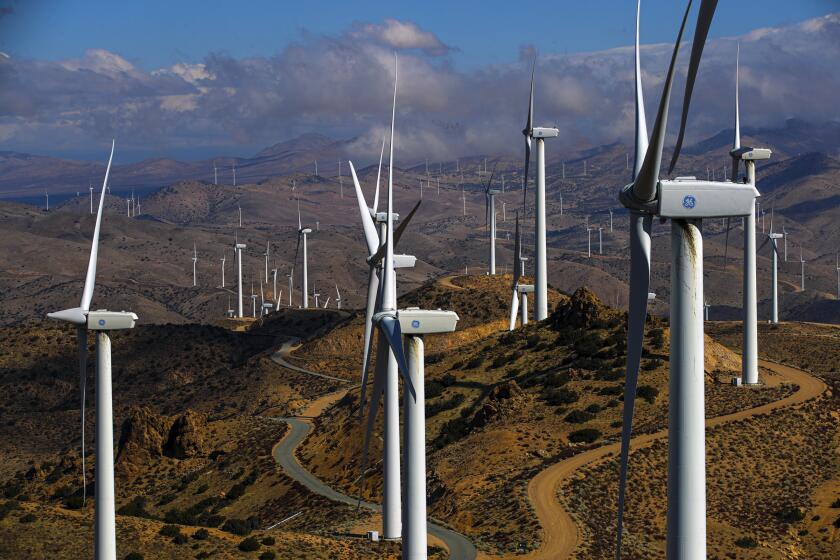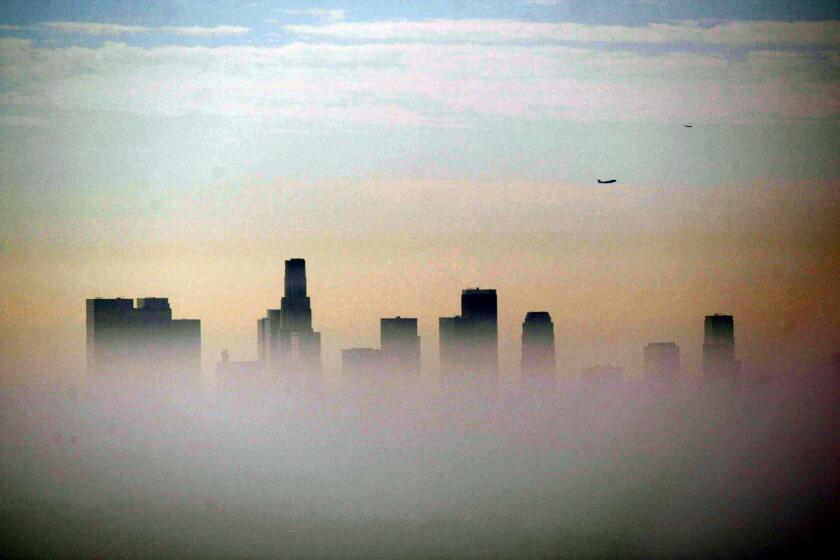EPA proposes new standards for most dangerous type of air pollution

- Share via
Declaring that current standards are no longer sufficient to protect public health, the Environmental Protection Agency has proposed strengthening federal rules for one of the world’s most dangerous and pervasive types of air pollution — fine particulate matter.
EPA Administrator Michael S. Regan announced Friday that the agency intends to further restrict annual concentrations of so-called PM2.5 — microscopic particles that are contained in diesel exhaust, wildfire smoke and other emissions and are known to trigger heart attacks and respiratory illness.
The potential measure, which could be enacted this year following public meetings, could prevent thousands of premature deaths, the agency estimates.
“The true significance of strengthening this key health standard [is] the transformative benefits it will bring to communities across our nation,” Regan told reporters. “Fine particulate matter is both deadly and extremely costly.”
The California Air Resources Board has released its long-awaited scoping plan, a roadmap for the state to drastically cut its carbon emissions.
The new rule would represent a 17%-to-25% reduction over the current national health standard enacted in 2013 and would limit PM2.5 to 9 and 10 micrograms per cubic meter. The current standard is 12 micrograms.
The EPA proposal was informed by thousands of scientific studies that consistently concluded exposure to fine particulate pollution is much more dangerous than once thought.
“We know that particle pollution kills people,” said Paul Billings, national senior vice president of public policy for the American Lung Assn. “It causes a wide range of adverse health consequences: heart attack, asthma attack, stroke. It is a potent killer. Now we have more scientific literature that supports these findings, and it shows that at lower levels than previously understood that harm is occurring.”
When inhaled, these microscopic particles travel deep into the lungs and venture into the bloodstream, where they can induce cardiac arrest or asthma attacks. Children, seniors and people with preexisting conditions are especially vulnerable to these effects.
Nowhere in the nation are the health concerns from this form of pollution more acute than California — a state crosshatched with heavily trafficked highways, dotted with diesel-congested seaports and bordered by mountains that don’t allow this toxic haze to dissipate.
Despite its legacy of spearheading groundbreaking air quality regulations, California remains home to four of the five national regions that still fail to comply with existing rules for fine particulate pollution: Greater Los Angeles, the San Joaquin Valley, Imperial County and Plumas County.
The lion’s share of particle pollution in Southern California comes from transportation, which state regulators are attempting to curtail with a ban on the sale of new gasoline-powered cars by 2035, and a proposal to transition heavy-duty trucks to zero-emission technology.
The federal government, for its part, last month adopted stronger emissions standards for heavy-duty trucks.
Fine particulate is a catchall term for any airborne debris 2.5 micrograms or smaller — nearly 30 times smaller than the width of a human hair. This pollution is produced by a variety of sources — including emissions from vehicle tailpipes, industrial smokestacks, wind-blown dust from unpaved roads and soot from fires. Although inhaling microscopic particles, by itself, is harmful, the source and chemical composition may make some more dangerous than others.
In Southern California, some of the highest concentrations of particulate pollution occur near highways, which often cut through areas largely composed of lower-income communities where residents may have limited access to medical care.
Southern California air regulators have released a sweeping plan to help reduce smog pollution, but it will fall short of federal requirements.
Researchers from UCLA recently found that these areas of high particulate concentration also have higher levels of toxic particles as well.
“We found that the locations that are really close to freeways have the highest toxicity levels in general, which is maybe not terribly surprising,” said Suzanne Paulson, the senior author of the study and a UCLA professor of atmospheric and oceanic sciences.
The researchers also found that fine particles from wear and tear on vehicle tires and brakes appear to be a significant and growing source of particulate pollution, as evidenced by the increasing concentration of copper and iron. The California Air Resources Board, which funded the UCLA study, estimates brake and tire emissions have already eclipsed vehicle exhaust in the L.A. area in recent years.
Though the EPA rule proposal was largely welcomed by health and environmental advocates, some argued it fell short and failed to heed the advice from his own scientific advisory committee, a consortium of academics and experts. The majority of the panel recommended Regan propose an annual limit of 8 to 10 micrograms per cubic meter.
“The proposal falls far short of what the science indicates, and what the law requires,” said Billings of the American Lung Assn. “The EPA’s scientific advisory committee made clear recommendations to the administrator. These are independent experts, who recommended the range should be 8 to 10 for the annual standard, and pointed out that people of color and low-income communities bear a disproportionate burden of pollution.”
Officials at the ports of Los Angeles and Long Beach recorded an unprecedented surge in harmful emissions during 2021. They blame COVID-19.
This committee also suggested the agency lower the 24-hour standard for fine particulate (which is intended to protect the public from short-term outbreaks of pollution) to somewhere between 25 and 30 micrograms, from its current 35 threshold. The EPA recommended that benchmark remain the same.
“Really, it’s a missed opportunity and it leaves many communities without the protections that the Clean Air Act requires,” Billings added.
Regan said the agency will consider public comment on whether to lower the yearly standard and amend the 24-hour benchmark.
At the EPA announcement, Regan was joined by Dr. Doris Browne, an oncologist and former president of the National Medical Assn., the oldest national organization representing African American physicians and their patients. She expressed optimism that the rule change would help solve one of the foremost threats to public health in communities of color.
“No one should be sickened by the environment they live in,” Browne said, “and the EPA’s proposal marks the start of changes that will have lasting impacts in communities all over, especially Black and brown communities that often experience increased PM pollution.
“Harmful air pollution can have lasting and devastating impacts on people’s health,” she said, “but by strengthening air quality standards, we can ensure healthier, more sustainable communities across this country.”












